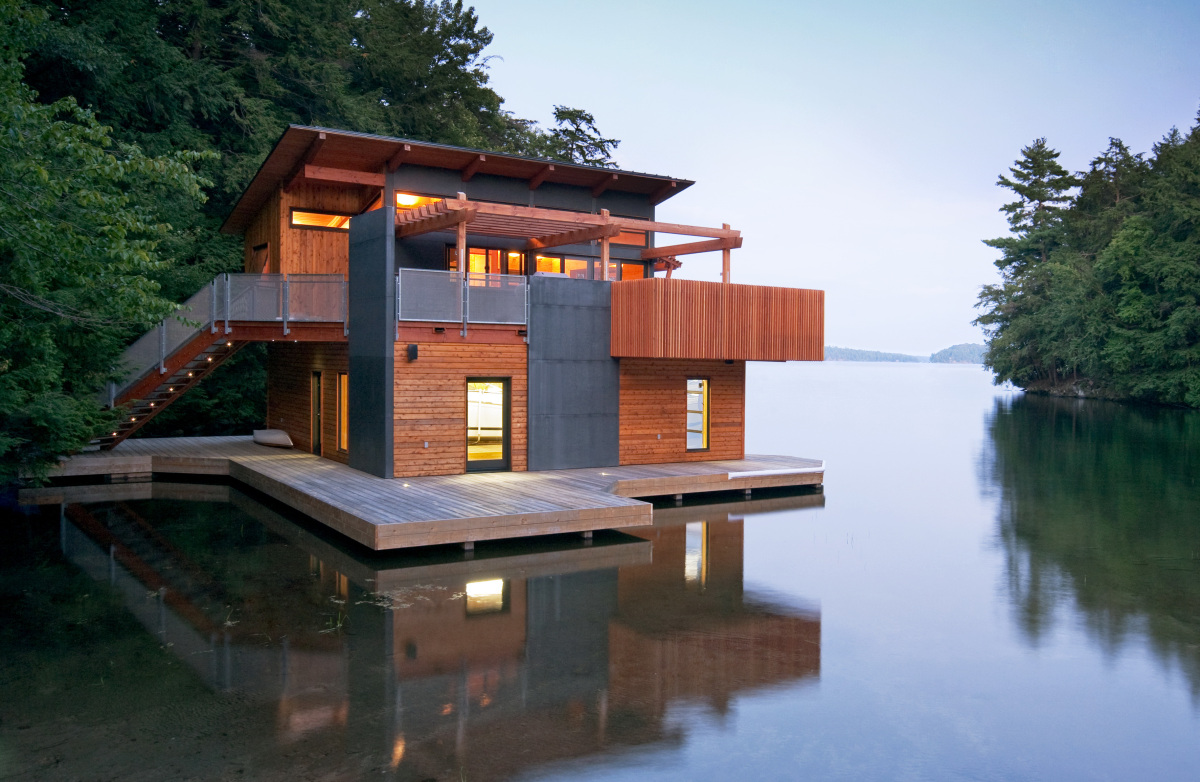Imagine living in a floating home on the water, waking up to stunning lake views. Or perhaps you dream of a finger lakes treehouse, nestled among towering trees, escaping the everyday hustle and reconnect with nature. This guide explores the captivating world of floating homes, covering various types, costs, designs, and the eco-friendly aspects of aquatic living.
Discovering the Allure of Floating Homes
Floating homes, also known as float homes, offer a unique blend of tranquility and adventure. From cozy cabins ideal for weekend escapes to architectural marvels, these homes provide a lifestyle deeply connected to the water. They’re no longer just repurposed boats; modern floating homes represent innovative and stylish waterfront living.
Exploring Different Types of Floating Homes
Floating homes come in various styles and sizes:
- Houseboats: These classic floating homes, often mobile and self-propelled, allow exploration of waterways. They range from simple to surprisingly spacious and well-equipped.
- Floating Cabins: Compact and charming, these cabins emphasize a connection to nature, often incorporating off-grid features like solar power.
- Barge Conversions: Old barges are cleverly transformed into unique, spacious homes, often featuring industrial-chic aesthetics and customization options.
- Modern Architectural Designs: Architects are pushing boundaries with sustainable, aesthetically pleasing designs, incorporating sleek lines, expansive windows, and eco-friendly materials.
Building a Floating Home: Materials and Methods
Floating homes utilize engineered floatation systems, typically pontoons or concrete hulls, providing buoyancy. Construction materials include wood, concrete, steel, and composites. Utility hookups are integrated, offering standard home comforts. Careful engineering and planning ensure stability, safety, and comfort.
Weighing the Pros and Cons of Floating Home Living
Like any lifestyle choice, floating home living has advantages and disadvantages:
Advantages:
- Unbeatable Waterfront Views: Enjoy picturesque sunrises and sunsets from your private oasis.
- Nature Immersion: Experience the tranquility of water, sounds of wildlife, and fresh air.
- Community Spirit: Floating home communities foster close-knit relationships and shared experiences.
- Off-Grid Living Potential: Incorporate sustainable technologies like solar power and rainwater harvesting.
Disadvantages:
- Higher Initial Costs: Specialized construction and unique locations contribute to higher purchase prices.
- Ongoing Maintenance: The marine environment necessitates diligent upkeep, which can be costly.
- Financing Challenges: Securing mortgages for floating homes can be more complex.
- Weather Vulnerability: While designed for typical conditions, floating homes are more susceptible to severe storms and fluctuating water levels.
Navigating Legal Waters: Location and Regulations
Regulations vary significantly depending on the location. Research local rules regarding permits, mooring, and environmental considerations before pursuing a floating home. Cities like Seattle, Portland, and Sausalito, known for their floating home communities, each have specific regulations.
Adapting to a Floating Lifestyle
Life on the water involves embracing a new way of life:
- Embracing Water’s Rhythm: Adapt to tides, currents, and passing boats.
- Community Connection: Floating home communities often foster strong social bonds.
- Environmental Stewardship: Living on the water encourages eco-conscious practices.
Designing Your Dream: Architecture and Style
From traditional to modern, the design possibilities are endless:
- Traditional Aesthetics: Embrace classic houseboat charm with wood paneling and nautical accents.
- Modern Minimalism: Opt for clean lines, open floor plans, and large windows to maximize views.
- Innovative Designs: Explore sustainable materials, smart home technology, and unique features like floating gardens and rooftop decks.
Maintaining Your Floating Home: Essential Care
Maintaining a floating home requires specific attention:
- Hull Care: Regular inspections, cleaning, and repairs are vital for longevity.
- Dock Maintenance: Ensuring dock safety and accessibility is crucial.
- Water-Related Issues: Address leaks, moisture control, and fluctuating water levels promptly.
Beyond the Dream: The Hidden Costs & Challenges of Floating Home Ownership
While idyllic, floating homes come with challenges:
- Weather Vulnerability: Storms and fluctuating water levels can impact stability and require specific adaptations. Motion sickness can be a concern for some.
- Higher Maintenance: Exposure to the elements necessitates frequent upkeep and specialized repairs. Mooring fees add to the ongoing costs.
- Utility Challenges: Connecting and maintaining utilities can be complex and potentially expensive.
- Limited Storage: Downsizing and embracing minimalism are often necessary.
- Financing & Insurance: Securing loans and insurance can be challenging and more costly.
- Limited Availability: Finding the right floating home can be difficult due to limited inventory.
| Potential Downside | Description |
|---|---|
| Weather Vulnerability | Susceptible to storms, fluctuating water levels, and strong winds. |
| Motion Sickness | Constant movement can cause discomfort. |
| Higher Maintenance | Specialized materials and exposure to elements increase upkeep costs. |
| Utility Challenges | Connecting and maintaining utilities can be complex. |
| Limited Storage | Smaller living spaces require downsizing. |
| Financing & Insurance | Securing loans and insurance can be complex and costly. |
| Limited Availability | Fewer available homes and locations. |
Floating architecture is constantly evolving, with ongoing research addressing challenges. Be aware of potential downsides and weigh them against the benefits. Consulting current floating homeowners is invaluable.
Decoding Floating Home Costs: A Comprehensive Guide to Waterfront Living
The cost of a floating home varies significantly, from around $30,000 for smaller options to millions for luxurious residences.
Factors influencing cost include:
- Location: Prime waterfront locations command premium prices.
- Size and Condition: Larger and newer homes generally cost more.
- Features and Amenities: Luxury features increase the price tag.
- Mooring/Slip Fees: These are recurring costs for your water space.
| Expense Category | Estimated Range |
|---|---|
| Purchase Price | $30,000 – $1,000,000+ |
| Mooring/Slip Fees | Variable based on location & marina |
| Annual Additional Costs | Variable (Insurance, maintenance, property taxes, utilities) |
Financing may require specialized lenders. Resale value depends on location and market demand.
Pros: Waterfront views, nature connection, community, off-grid potential.
Cons: Higher initial costs, ongoing maintenance, financing challenges, weather vulnerability, limited storage.
Carefully consider the costs, expenses, and local regulations to make an informed decision about floating home living.
What is a Floating House? Exploring the Concept, Types, and Future of Waterborne Living
A floating house is a permanent dwelling on water, distinct from a mobile houseboat. It relies on buoyancy, where the structure displaces enough water to support its weight. Various flotation devices, like pontoons or concrete hulls with Styrofoam cores, achieve this. They are typically moored or anchored in designated areas or communities.
Construction and Design: Building on Water
Floating homes come in various sizes and styles, from compact cabins to multi-level homes. Construction materials include concrete, wood, steel, and recycled plastics, often prioritizing sustainability. Designs range from traditional to modern, incorporating green roofs and living walls.
Perks of Living Afloat: The Upsides
- Uninterrupted Waterfront Views: Enjoy stunning water views daily.
- Inherent Flood Resilience: Floating homes adapt to changing water levels, mitigating flood risks.
- Potential for Sustainable Living: Incorporate solar panels, rainwater harvesting, and composting toilets.
Challenges of Waterborne Living: The Downsides
- Susceptibility to Motion: The rocking motion may cause seasickness for some.
- Unique Maintenance Needs: The marine environment requires specialized and potentially costly upkeep.
- Limited Storage: Space optimization and a minimalist approach are essential.
Key Considerations: Weighing the Pros and Cons
| Feature | Advantage | Disadvantage |
|---|---|---|
| Lifestyle | Unique waterfront experience | Potential for motion sickness |
| Resilience | Flood protection | Specialized maintenance |
| Sustainability | Eco-friendly features | Possible size and storage limitations |
Ongoing research and technological advancements continually improve floating home design and address challenges. They offer a compelling alternative to traditional housing, prompting us to reconsider our relationship with water and explore the possibilities of a life afloat.
- Backsplash For Gray Cabinets: Choosing the Right Backsplash Style - December 13, 2025
- Gray And White Backsplash: Ideas For Timeless Style - December 12, 2025
- Gray Kitchen Backsplash Ideas: Find Your Perfect Gray Tile - December 11, 2025









